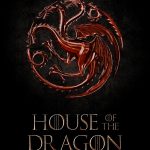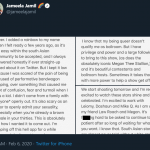“gen:LOCK”: A Mature Animation Which Takes Risks
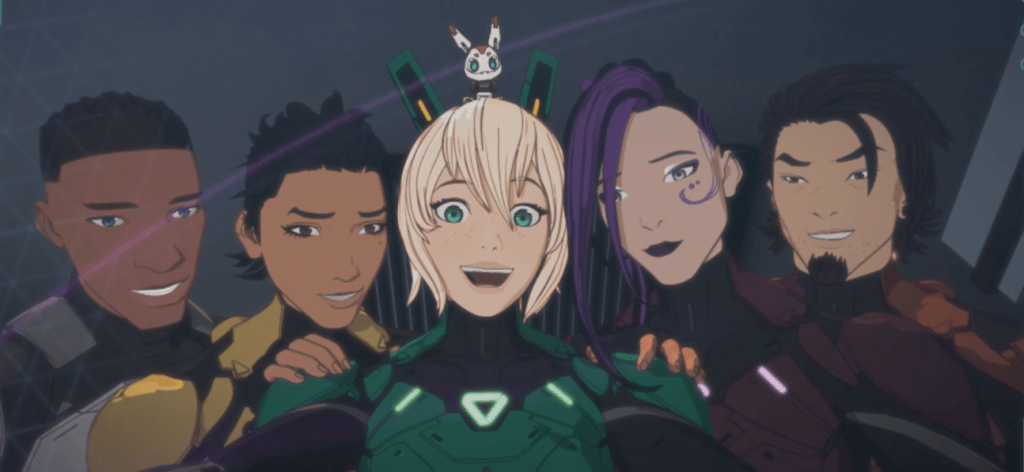
What if you could upload your mind to a huge robot and save parts of it with other people? gen:LOCK, an anime-influenced mature animated series set 50 years in the future, tries to answer that question. This series takes risks with its LGBTQ themes, focus on trauma, science, religion, climate change, and much more! Let’s go in-depth and look at how this series explores these concepts.
The basics of gen:LOCK
gen:LOCK centers around members of the gen:LOCK program, who upload their minds to huge mechas which known as “Holons.” In this dystopia, an international group known as The Polity fights an invading force known as The Union. According to Dan Dominguez, the showrunner for season 2, the Union is a hyper-religious state which rules as a “post-capitalist theocracy.” The Polity, on the other hand, is “an oligarchy of secular capitalists.” The series began airing on Rooster Teeth and Adult Swim on January 26, 2019. After an over two-year hiatus, this anime-influenced mature animated series returned on HBO Max on November 4, 2021.
As a warning, this review discusses some spoilers for gen:LOCK. It will also discuss topics such as death, blood, murder, suicide, trauma, and sexual intercourse.
The show’s eight-episode first season introduces viewers to the gen:LOCK team, an experimental science unit led by Dr. Rufus Weller (David Tennant), with former military pilot Julian Chase (Michael B. Jordan) and Iran-born resistance fighter Yasamin ‘Yaz’ Madrani (Golshifteh Farahani) as its first members. Later recruits include Irish hacker Cameron “Cammie” MacCloud (Maisie Williams), former Japanese military operative Kazu Iida (Kōichi Yamadera), and former Russian secret forces agent Val/entina ‘Val’ Romanyszyn (Asia Kate Dillon). While Madrani, Cammie, Kazu, and Val have no family left, Chase has a mother, Roberta (Shari Belafonte), and sister, Driana ‘Dri’ (G.K. Bowes), who were said to be lost in the show’s first episode. Throughout the season, he tries to reconnect with his ex-girlfriend, Miranda Worth (Dakota Fanning). The team works on behalf of Polity’s military commander Col. Raquel Marin (Monica Rial) as they try and stop the Union’s military advance, with Chase fighting alongside his comrades against a copy of himself, known as Nemesis, in mechanized robots piloted by their minds.
The eight-episode second season of gen:LOCK picks up 4-6 months later, with the team barely fighting off copies of Chase known as the Nemesi. Dr. Fatima Jha (Anisha Nagarajan), scientist and ex-wife of Dr. Weller, defects to the Union, working on their doomsday weapon known as the Twilight Project. Chase struggles with his inner demon. Marin confronts Marc Holcroft, a powerful investor and political figure (Matt Hullum in Season 1, Kiff VaudenHeuvel in Season 2) about his deception. Cammie leaves the team and “ascends” while Kazu dies in a bloody battle. In the final episodes, the team work together to save everyone, and turn into nanotech. The Union falls, with Brother Tate (Angus Sampson) murdered by a monster he helped create and the team decides their own destinies.
Genderfluidity and LGBTQ themes
In the season one episode “Training Daze,” Val tells their team members that they are genderfluid after they appear in the virtual reality world, Ether, in a masculine form. They explain to a confused and uncomfortable Kazu their body is physically female presently but are thinking of a change. They tell Yaz they have shifted their gender several times in the past and may do in the future. They state that sometimes they are male, but not at present.
When Kazu asks Val what they were born as and they tell him that he will never know. Val explains this as sensibly as Caraway telling Rosemary he is transgender in the third episode of High Guardian Spice. In fact, Cammie recognizes Val is genderfluid off the bat, but notes it is not her place to talk about it, letting Val describe it in their own words.
Val is groundbreaking as a character. Genderfluidity is a “question of internal personal identity.” It is more than one’s gender expression, referring to a gender expression or non-binary gender identity, or both, which can change over time.
Val smashes apart the tropes often attributed to genderfluid characters. Val doesn’t change their gender with the flick of a switch. They are not duplicitous, do not have many personas, nor are they insecure. Their assigned gender is only briefly mentioned. Instead, Val is voiced by Dillon who describes their gender identity as falling “outside the boxes of man or woman,” identifying as “neither a man or a woman.”
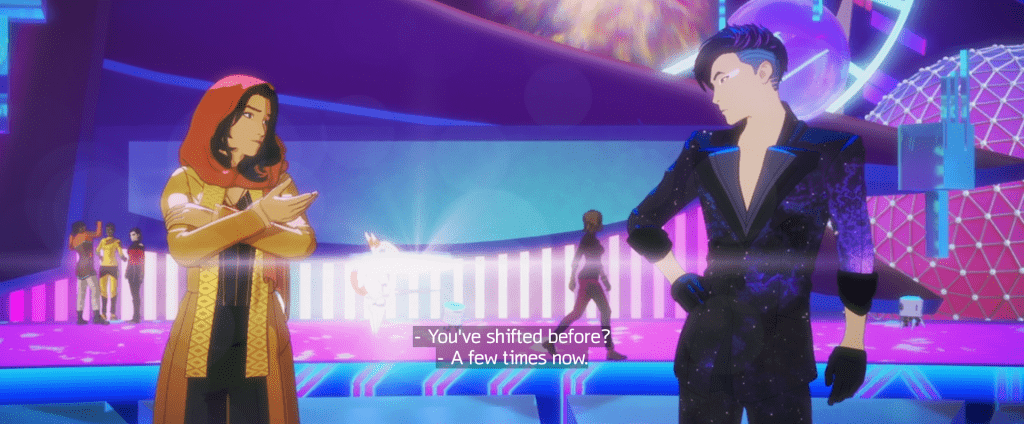
After Tatiana Maslany (who played a trans man in Orphan Black) turned down the role, insisting that “trans actors should play trans parts,” it led the show to cast Dillon. Val’s genderfluidity is only part of their character. They are a skilled fighter who usually has a positive nature. In the season 2 episode “Together. Together”, Val kisses a girl and tells their friend, Oleg, that they are pansexual. They then beat up someone who insults them with a queerphobic slur.
The show’s second season expands on Val’s identity and goes beyond. Kazu has an identity crisis of sorts. He says he has issues with his avatar’s form, which is presenting female, with Yaz saying that while he looks different, he is still a man. Cammie agrees to assist Kazu who wants his avatar restored to its “true” form. He blames the change on Val mind sharing with him. Cammie later finds out that his code hasn’t changed. Rather the avatar’s change is due to his subconscious.
Val talks with Kazu about it, saying they can restore his avatar. They conclude that he is so afraid of being vulnerable that his subconscious made him female. They criticize him for manifesting the idea that femininity is weakness, something inherent in his toxic masculine bravado. Val believes that the only answer is to dig deeper into Kazu’s past, but, he is afraid to revisit memories due to a rough childhood. Both connect with each other and kiss, sharing their insecurities with one another.
Kazu’s gender change is not a sign he is genderfluid like Val, or that he is trans. Instead it is a twisted and warped expression of his vulnerability. It is possible he is queer, as he has sex with Val when they are in their male form, but that part of him isn’t explored in the show.
According to the show’s companion podcast, Kristle Peluso, writer for the episode “Together. Together,” said there is mutual recognition of traits between Val and Kazu, both coming together to deal with their traumas. Val assists Kazu with his gender expectations, toxic masculinity, and his incorrect association of weakness with femininity.
Apart from Kazu, we can say with confidence that the real Robert Sinclair (Blaine Gibson), not the fake Union spy, is gay. He kisses his boyfriend, Chris, in the episode “The Grand Guignol.” He even calls out to him after the Polity kidnaps him. His voice actor described him as a fighter and lover who is doing some “pretty rad” stuff assisting people in no-man’s land.
Trauma and the subconscious in gen:LOCK
Trauma and the subconscious are major themes in gen:LOCK, mainly by the show’s main character, Chase. In both seasons he has to kill copies of himself, but in the second season he wrestled with a demon in his mindscape who haunts him. Over the course of the season he first pushes away his team members who ask him for help, but later accepts their assistance.
Chase learns that the demon is another version himself and embraces it. Chase’s other self tells him that he needs to be whole and says he doesn’t need to be a copy. Instead, he can “be the upgrade.” Chase lets in the demon/other self into his mindscape and they become one.
Singleton also argued that although some may interpret that Cammie committed suicide, there is more to “ascension.” Cammie sees her ascension as joining a community after her gen:LOCK family shunned her. As he described it, she wanted to be part of a bigger family and had been into mind sharing more than others on the team. Cammie reappears in a body that is able to manipulate the nanobots but is still figuring out how to control it. In the final episode, Cammie describes herself as a symbol of both sides of the war coming together, a path to the end of the war, a path which Val, Yaz, and even Chase, join.
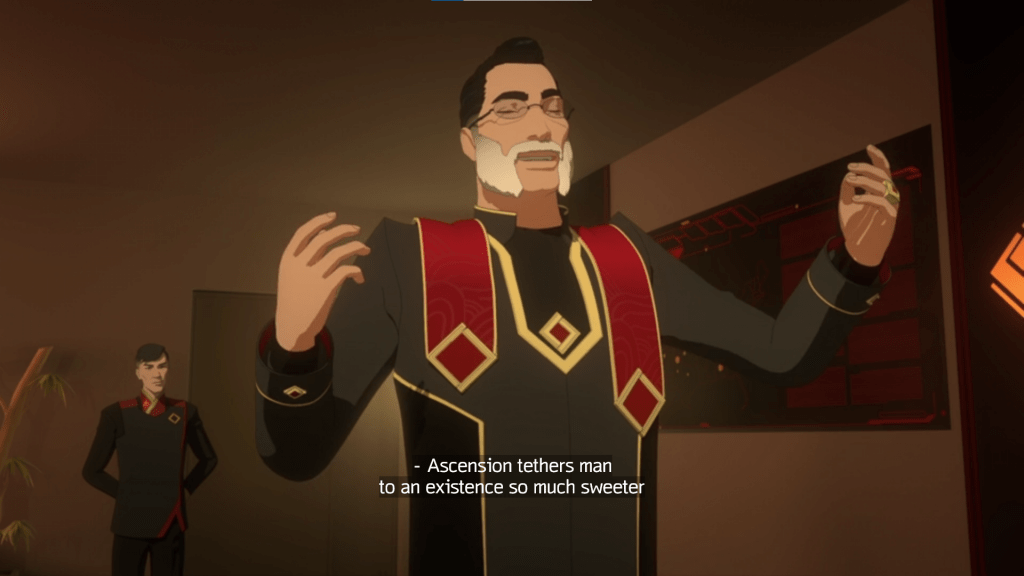
Another theme is the brutality of war and the trauma which comes with it. Chase is emblematic of those who only exist in copies as he has been severed from his physical body. His relationship with Miranda becomes non-existent as she believed he was dead for four years!
Tate sends the copy of Chase in the Union to a sort of hell because he felt “forced” to go to extremes to stop the Polity. In another episode, the Polity activates the Hammer system and kills everyone on the battlefield, including Jodie, which shocks Tate.
The story of gen:LOCK harps on many themes. One of those is the importance of family, especially for Chase. He is often thinking about his mother and sister. The gen:LOCK team are like a family of sorts as well.
The draw of family is one of the reasons that Cammie ascends and joining the Flow in the episode “The Grand Guignol.” She believes she is part of the Union’s “true community” and those in Babylon remind her of her childhood. In the final episode, Chase and Dri reunite and pledges to stay with her at the end of the episode.
The struggle between the individual and the collective is an important theme in gen:LOCK. One of the ways that the team can fight the Union is to share minds. As a result of the process, you lose a part of yourself, with parts of each person feeding into someone else, with your body decanted to a digital space.
For Chase, this becomes a sticking point, since all he has left is his memories. So, he is very reticent to mind share, especially after he exceeds his uptime (how long a cyberbrain can run before it has to return to a body without causing bodily harm).
The sub-story of Robert Sinclair leading a rag-tag group of rebels, ferrying people out of no-man’s land to New Zealand, is symbolic of the pull between the collective and the individual. He wants to assist people, but he wants to do it alone without anyone else. He does not want to choose sides in the war, after seeing the horrors of the Union and the Polity executing Union soldiers who had surrendered. He is on no one’s side in the war. Chase and his sister Dri later seem to come to the same conclusion.
Holocroft later brings Sinclair to a secret facility so he can become a huge robot named Odin. Luckily, Cammie frees Sinclair from this nightmare. In the final episode, he uses Odin to fight off the Twilight beast, even able to defeat it on his own terms.
Those in the gen:LOCK team all have something in common: they are dealing with a lot of emotional trauma and stress. For instance, Chase is killing copies of himself over and over again, and the team is being worn down. The gen:LOCK team are only some of the characters in popular media who experience stress and trauma.
Maturity and taking risks
The content of the series is mature. The show’s first season is rated TV-14 for suggestive dialogue, language, and violence. The second season’s rating increased further to TV-MA for language. There is a warning that the episodes may “trigger seizures for those with photosensitive epilepsy.”
The second season is darker and more mature than the first. The third episode of season 2 has an additional warning for “sexual situations,” i.e. when Chase accidentally walks in and sees Miranda having sex with Jodie, and there is a scene in a robo strip club, with Kazu and Val drinking together at a bar.
gen:LOCK, like Arcane at times, displays heterosexual relationships more openly than possible queer ones. The sex scene between Miranda and Jodie is a bit awkward, like the sex scene between Jayce Tallis and Mel Medarda in Arcane. But Vi and Caitlyn, two women in love with one another, don’t kiss in the show’s first season, even though they are the signature romance of the series! In gen:LOCK, the romance between Chase and Miranda has a prominent role in the first episode and is an undercurrent in the series.
The voice actor for Jodie, Chad James, noted that Miranda and Jodie had relationship friction, and said that he made Jodie more annoying in the sex scene. He revealed the name “Jodie” refers to someone who sleeps with a soldier’s girlfriend while the soldier is away on deployment.
gen:LOCK is a dark, mature series, especially by the second season. The violence experienced is a result of the war itself. It is yet another reminder of the consequences of war, something which affects everyone. The series does not have excessive cruelty or kill off characters for “shock value.” Rather, specific people are dying for specific reasons.
To give one example, Cammie believes she can’t take it anymore and ascends at the end of the episode “The Grand Guignol.” She doesn’t “die” but rather she gains new life, almost a sort of reincarnation. It is sad to see characters like Jodie and Kazu die, but there’s a lot of misplaced anger and outrage. Such feelings were inevitable because many episodes are heartbreaking and emotionally tense.
gen:LOCK excels at raising anxiety-inducing morality questions. The show’s head writer, Daniel Dominguez, said that he doesn’t believe in heroes or villains, good or evil. He argued that morality is grey, rather than something that is black or white. He also described the show as about people entering into adulthood.
Marin says something similar to Chase in the episode “The Grand Guignol.” She declares that the Polity aren’t “good guys.” Rather, they are soldiers, not superheroes, saying his black-and-white morality doesn’t apply, justifying atrocities. She claims that Chase’s instability a virus which has infected the gen:LOCK team and worries about it spreading. Miranda tries to convince Marin to change her ways as rises up the Polity hierarchy, but is unsuccessful.
Both the Polity and the Union have done despicable things. They justify them within their own ideologies, leading to despair, death, and suffering. For instance, Marin does not care if the Polity’s strike on Babylon kills civilians. Nor does she care about the Polity pilots killed by the Union’s anti-aircraft weapon. There are questions about situational morality throughout the show. No one is evil without repose.
Nothing is sacred in this show. The Union platform, in the first episode, knocks over the Statue of Liberty, causing it to crumble into pieces, a direct response to the destruction of the Kaaba by the Polity. As writer Kristie Peluso put it in the show’s companion podcast, the series is making clear the brutality of war and moral greyness. Kazu’s death is an example of this brutality, as he is dead in the physical world but will live on in their memories. You could even argue that the show itself has a strong anti-war stance.
Science, religion, and climate change in gen:LOCK
The show raises the question of whether science and technology should be used for civilian or military purposes. It also focuses on organized religion like Disenchantment. For instance, the gen:LOCK program, as Dr. Weller states in season one, was meant for peaceful purposes. But the Polity used it to fight battles. Still, Weller believed it could save lives and end the war.
This is the case with nanotech, too. Originally intended to help stave off climate collapse, the Union later used it to tear apart soldiers of the Polity and became a justification for why the Polity attacked the Union in the first place.
The ability to copy others is used for devastating effect. Copies of people cause much of the damage, death, and destruction in the war. Cammie works on technology allowing them to connect virtually to holons. Dr. Jha, works on the Twilight Initiative, a doomsday weapon of some part which the Union has in its arsenal, a last resort if the Polity gets too close to victory.
To prepare for the use of this initiative, in the episode “The Third Way,” Tate prepares a field test in no-man’s land of the nanobots, consuming people and everything else. In the show’s final episode, Cammie projects Chase into the Nemesi and frees them.
In the Union, there is the Omnifaith, a hybrid of all the religions of the world combined into one. In this religion, people take part in mass suicides, called the “Ascension,” and have their bodies join the Flow, an energy force/mist. This is done with the belief they will go to the afterlife. It can be reportedly controlled if someone listens to it. This religion mixes science and religion, creating zealots, including the mother of Chase and Dri. Tate’s beliefs are complete hogwash as the Twilight monstrosity kills Tate without a second thought.
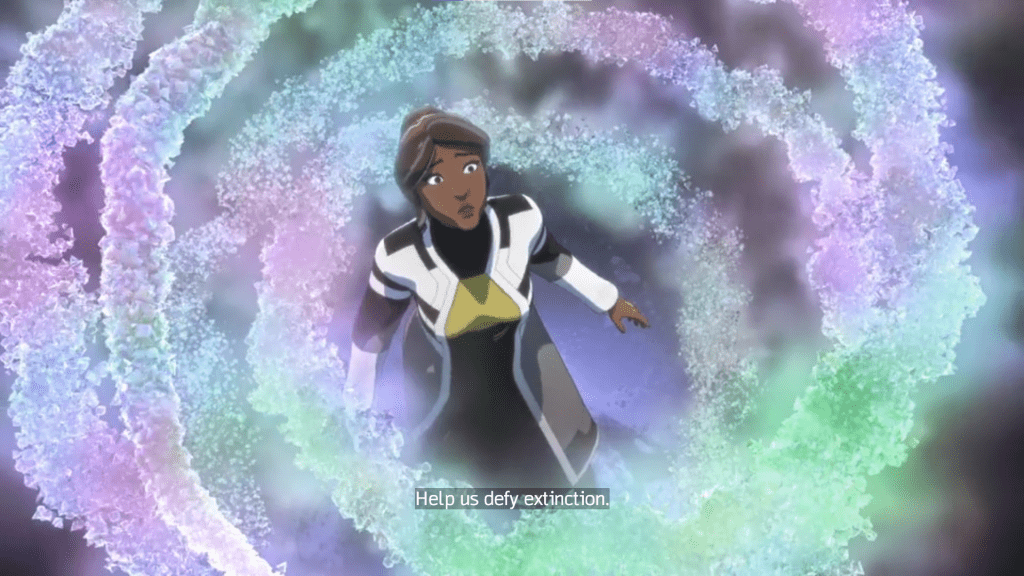
The mist that people are turned into once they “ascend”, is as writer Maasai Singleton put it, the same thing that the Polity calls the “smoke.” Those in the Union see the Flow as a form of ancestor worship. Even so, she argued that the Union is not a cult. Yaz and Chase are directly affected by the ascension, as their parents engage in the ritual. Tate even claims that those who don’t ascend are lost to the dust.
In some ways, those in the secular Polity have faith of sorts. Sinclair argues that both the Polity and Union worships gods they invented: robots. Marin demands loyalty and belief in the chain of command, not accepting anyone questioning her decisions. This is despite the fact that she could have caused Chase to be less skeptical of her if she had divulged some of the information. Her paranoia even causes her to order covert surveillance on the gen:LOCK team.
According to Singleton, the show was inspired by the real-life effects of climate change. Cammie comes from a family killed by a disease as a result of climate change. Marin and Tate hailed from places affected by climate change. The latter is from Australia and the former from Puerto Rico. Brother Tate saves a koala named Mr. Cook in Australia where wildfires and human animal cruelty are threatening many koalas.
In the episode “The Third Way,” Jha says that before Mars, the poor had to make “peace with climate death.” She says she sided with the Union because the Polity were cashing in on “false hope.” In another episode, New York faces another deluge, with Tate lamenting the inevitable vanishing of the city. This means the sow has a strong parallels to Sherwood and Gargantia on the Verdurous Planet, series which are set years after the climate catastrophe.
Music, voice acting, and cast
The show’s music selection is an important draw for the series. The opening theme of the first season is catchy. It is the song “Belgrade”, performed by Battle Tapes. This band does much of the series’ music. This music accompanies an introduction which shows an “evil” Chase in the second half of the first season.
The second season has a similar introduction except it only has “elegant” electronic music. Chase and Kazu glitch and nanobots consume Cammie. The opening sets the tone for each episode, preparing you for the episode to come, like the beginning of RWBY episodes. Battle Tapes continued to perform some music in the second season. The soundtrack is one of the strongest points of this series with some episodes having dramatic rock music.
The voice acting of gen:LOCK is smooth and natural. It is coupled with detailed background art and animation. Many of the voice actors are well-known for their roles in animated and live-action series. Jordan is well-known for portraying Erik “Killmonger” Stevens in the 2018 Black Panther film and in two episodes of What If…?. Similarly, Dillon is known for their role as Taylor Mason in Billions and Brandy in Orange Is the New Black. Other voice actors have had many anime, animated, and live-action roles.
The cast is diverse, composed of Black men, Black women, a Japanese man, an Iranian woman, a Latine man, and those of Spanish, Indian, Indigenous, Cuban, and French Polynesian descent. Rial said that when she voiced Marin, a Latine character who is Puerto Rican, she paid homage to her dad. She also described that she spoke to her friends about Marin’s accent in the show to make sure she got it right.
In the episode “The Grand Guignol,” Marin talks about her Puerto Rican identity. She notes that her grandmother was the governor of the island, and instituting martial law during a climate disaster. She argues that these actions saved lives.
The characters are a diverse grouping. For instance, Chase is a Black man and core of the story. Evan Narcisse, who wrote Rise of the Black Panther, joined the writers room of the show, working to define and inform Chase as a character. The reported death of Chase’s mom and sister are an important influence on his character. The mechanic, Migas, has a Latine Texas accent with “Louisianian tones,” which was, according to his voice actor, inspired by his family.
In the Ether, Yaz wears a hijab, Cammie is a bunny, Kazu has a tough look, and Julian wore more casual clothes than anyone else. Furthermore, Fatima Jha is a Indian woman and major Polity scientist. All these characters are dynamic and carry the story forward, each in their own way. This series does diverse characters right. This is something which other shows should emulate rather than having stereotypical characters.
Those working on gen:LOCK are a talented group of people. For instance, season one executive producer Burnie Burns is a former CEO of Rooster Teeth, creator of Red vs. Blue, and executive producer of RWBY. Jordan, apart from his television and film roles, co-produces the series through Outlier Society Productions, his production company. Mayo, president of Orion Pictures, served as Head of Production for Outlier Society. She was married to actress Lena Waithe until 2020.
Levin, producer for the gen:LOCK‘s second season, was an executive producer for various live-action series. Hall, another executive producer on the season, assisted with many live-action productions. Luna, one of the voice actors, wrote for many Rooster Teeth series such as RWBY and Camp Camp, and developed Nomad of Nowhere. Kristle Peluso, who wrote for High Guardian Spice and Onyx Equinox, also wrote for gen:LOCK. Daniel Dominguez, head writer of the series, said that he made all the writers re-watch the first season before they began writing second season.
The show’s creator, Greg Haddock, voiced Roman Torchwick in RWBY and formerly headed animation for Rooster Teeth. He is no longer working at Rooster Teeth following people calling out terrible work conditions at the company’s studio. He likely had a little or no role in producing Season 2. Haddock, Burnie Burns, and Matt Hullum were executive producers for the eight-episode first season. Ryan P. Hall and Jordan Levin were executive producers for the eight-episode second season. Michael B. Jordan and Alana Mayo were executive producers for both seasons.
Future of gen:LOCK after season 2
If gen:LOCK gets a third season, it will likely explore what happens to the main characters. At the end of the final episode, “Touch What’s In Front of You,” the members of the team go their separate ways. Chase stays with Dri in New York, Val and Yaz go to Babylon, and Cammie travels to meet Holcroft in Geneva.
Such a season could explore the journeys of each characters, who are still united in a quest to save the world, and humanity, from death. We did not see Caliban at risk as the Union, nor the Polity, realized he was a copy of Dr. Weller, but that would be another possible plotline for the season.
The show is a bit fractured across platforms. The show’s first season aired on Rooster Teeth, Crunchyroll, and Adult Swim, but the second season has only aired on HBO Max. While both seasons are on HBO Max, only season 1 is on Crunchyroll and Rooster Teeth. This makes watching it tricky unless one only watches it on HBO Max. Possibly on February 2, 2022, it will appear on Rooster Teeth’s website. It is not known whether season 2 will appear on Crunchyroll.
The second season was not “hollow” and did not have “bad” writing. It did seem a bit rushed. I wish there were more episodes to expand the story. This might be a result of the show’s crew trying to put in as much content as they can in light of having no third season. These are all signs that the show won’t get another season.
In the end, while I have my criticisms, gen:LOCK is a solid series. It has themes, ideas, and plots which will be relevant in the days, months, and years to come, even if some turn their nose up at the show.
Author: Burkely Hermann
Burkely is an indexer of declassified documents by day and a fan fic writer by night. He recently earned a MLIS with a concentration in Digital Curation from the University of Maryland. He currently voraciously watches animated series and reads too many webcomics to count on Webtoon. He loves swimming, hiking, and searching his family roots in his spare time.
Help support independent journalism. Subscribe to our Patreon.
Copyright © The Geekiary
Do not copy our content in whole to other websites. If you are reading this anywhere besides TheGeekiary.com, it has been stolen.Read our


